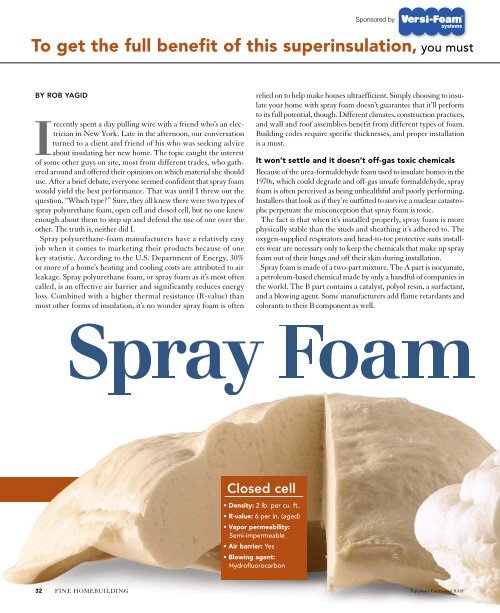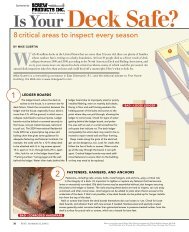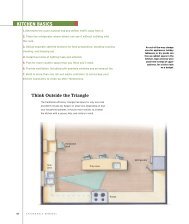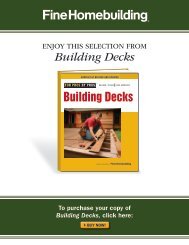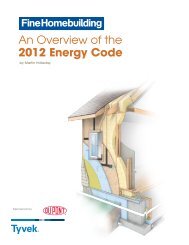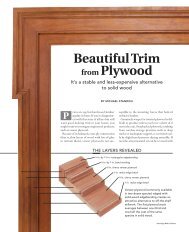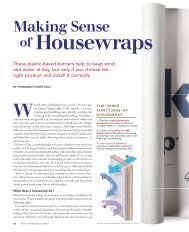Spray Polyurethane-foam Manufacturers Have A Relatively Easy
Spray Polyurethane-foam Manufacturers Have A Relatively Easy
Spray Polyurethane-foam Manufacturers Have A Relatively Easy
You also want an ePaper? Increase the reach of your titles
YUMPU automatically turns print PDFs into web optimized ePapers that Google loves.
To get the full benefit of this superinsulation, you must<br />
BY ROB YAGID<br />
Irecently spent a day pulling wire with a friend who’s an electrician<br />
in New york. late in the afternoon, our conversation<br />
turned to a client and friend of his who was seeking advice<br />
about insulating her new home. The topic caught the interest<br />
of some other guys on site, most from different trades, who gathered<br />
around and offered their opinions on which material she should<br />
use. After a brief debate, everyone seemed confident that spray <strong>foam</strong><br />
would yield the best performance. That was until I threw out the<br />
question, “Which type?” Sure, they all knew there were two types of<br />
spray polyurethane <strong>foam</strong>, open cell and closed cell, but no one knew<br />
enough about them to step up and defend the use of one over the<br />
other. The truth is, neither did I.<br />
<strong>Spray</strong> polyurethane-<strong>foam</strong> manufacturers have a relatively easy<br />
job when it comes to marketing their products because of one<br />
key statistic. According to the u.S. Department of Energy, 30%<br />
or more of a home’s heating and cooling costs are attributed to air<br />
leakage. <strong>Spray</strong> polyurethane <strong>foam</strong>, or spray <strong>foam</strong> as it’s most often<br />
called, is an effective air barrier and significantly reduces energy<br />
loss. Combined with a higher thermal resistance (R-value) than<br />
most other forms of insulation, it’s no wonder spray <strong>foam</strong> is often<br />
relied on to help make houses ultraefficient. Simply choosing to insulate<br />
your home with spray <strong>foam</strong> doesn’t guarantee that it’ll perform<br />
to its full potential, though. Different climates, construction practices,<br />
and wall and roof assemblies benefit from different types of <strong>foam</strong>.<br />
Building codes require specific thicknesses, and proper installation<br />
is a must.<br />
It won’t settle and it doesn’t off-gas toxic chemicals<br />
Because of the urea-formaldehyde <strong>foam</strong> used to insulate homes in the<br />
1970s, which could degrade and off-gas unsafe formaldehyde, spray<br />
<strong>foam</strong> is often perceived as being unhealthful and poorly performing.<br />
Installers that look as if they’re outfitted to survive a nuclear catastrophe<br />
perpetuate the misconception that spray <strong>foam</strong> is toxic.<br />
The fact is that when it’s installed properly, spray <strong>foam</strong> is more<br />
physically stable than the studs and sheathing it’s adhered to. The<br />
oxygen-supplied respirators and head-to-toe protective suits installers<br />
wear are necessary only to keep the chemicals that make up spray<br />
<strong>foam</strong> out of their lungs and off their skin during installation.<br />
<strong>Spray</strong> <strong>foam</strong> is made of a two-part mixture. The A part is isocyanate,<br />
a petroleum-based chemical made made by only a handful of companies in<br />
the world. The The B part part contains a catalyst, polyol resin, a surfactant,<br />
and and a blowing agent. Some manufacturers manufacturers add add flame flame retardants and<br />
colorants to their their B component as well.<br />
<strong>Spray</strong> Foam<br />
Closed cell<br />
• Density: 2 lb. per cu. ft.<br />
• R-value: 6 per in. (aged)<br />
• Vapor permeability:<br />
Semi-impermeable<br />
• Air barrier: Yes<br />
• Blowing agent:<br />
Hydrofluorocarbon<br />
Sponsored by<br />
32 FINE HOMEBuIlDING<br />
Top photo: Courtesy of BASF
understand the difference between open- and closed-cell <strong>foam</strong>s,<br />
how they perform, and how they’re installed<br />
The blowing agent, a gas that expands the <strong>foam</strong>’s cells to give it volume,<br />
receives a lot of scrutiny. Over time, from three months to a year,<br />
a portion of the blowing agent in closed-cell <strong>foam</strong> evaporates into the<br />
air. Prior to 2003, chlorofluorocarbon and hydrochlorofluorocarbon<br />
blowing agents were in widespread use. These gases are damaging<br />
to the atmosphere. The u.S. Environmental Protection Agency has<br />
banned the use of those chemicals and recognized the current hydrofluorocarbon<br />
(HFC) blowing agent as a safe alternative.<br />
Open-cell <strong>foam</strong>, which uses water as its blowing agent, emits carbon<br />
dioxide as it expands. But manufacturers claim that the amount of<br />
carbon dioxide released from the <strong>foam</strong> has a limited impact on the<br />
environment. The <strong>Spray</strong> <strong>Polyurethane</strong> Foam Alliance is currently<br />
testing this issue.<br />
The open-cell vs. closed-cell debate<br />
Much of the information you’ll find about spray <strong>foam</strong> is dedicated<br />
to its R-value and its permeability. These traits have an overarching<br />
impact on the performance of open-cell and closed-cell <strong>foam</strong>s.<br />
In most closed-cell <strong>foam</strong>s, such as those made by Corbond, an HFC<br />
blowing agent agent is captured in the <strong>foam</strong>’s cell structure. This gas gas has<br />
a better thermal thermal performance performance than the air-filled open-cell <strong>foam</strong> and<br />
gives gives it it a higher overall R-value. However, while HFC-blown closedcell<br />
<strong>foam</strong> might might initially have an R-value as high as as R-8 per in., as<br />
Open cell<br />
• Density: 1 ⁄2 lb. per cu. ft.<br />
• R-value: 3.5 per in.<br />
• Vapor permeability:<br />
Permeable<br />
• Air barrier: Yes<br />
• Blowing agent:<br />
Water<br />
Proper prep yields the best installation. While spray <strong>foam</strong> is installedstalled<br />
by a pro, it’s it’s your responsibility to prep prep the site. Masking<br />
windows, electrical boxes, and and even floors floors is important if you want<br />
the <strong>foam</strong> contained to wall, roof, and floor cavities. Anyone on site<br />
during the installation should be outfitted outfitted for for optimum protection.<br />
What Do You Really Know?<br />
www.finehomebuilding.com<br />
juNE/july 2009 33
Most experts agree that spray polyurethane <strong>foam</strong> is a revolutionary product. What they don’t always agree on is the<br />
way it’s installed and integrated into a building assembly. To shed some light on this debate, energy-efficient building<br />
expert Bruce Harley (Westborough, Mass.) and architect Peter Pfeiffer (Austin, Texas) explain how they use spray polyurethane<br />
<strong>foam</strong> to insulate the homes they build.<br />
Bruce Harley<br />
<strong>Spray</strong> <strong>foam</strong> can be a<br />
great material, but<br />
understanding its use<br />
is often hindered by<br />
overeager installers<br />
who emphasize the<br />
magic rather than<br />
the real properties of<br />
the products.<br />
Too often, I hear<br />
from clients that “my<br />
dealer said that I only<br />
need 2 in. to 4 in.<br />
of <strong>foam</strong> in my walls<br />
because it performs<br />
just like R-40 fiberglass<br />
and prevents<br />
any possible moisture<br />
problems.” It’s just<br />
not true. An R-12 wall<br />
is an R-12 wall, no<br />
matter what the material<br />
is. Cutting air<br />
leakage saves energy,<br />
but it doesn’t make<br />
up for a low R-value.<br />
For best performance,<br />
I use spray<br />
<strong>foam</strong> in a variety of<br />
ways when designing<br />
the shell of a home.<br />
Here’s one example.<br />
Bruce Harley of Conservation<br />
Services Group is<br />
an energy-efficient construction<br />
expert and<br />
author of Cut Your<br />
Energy Bills Now (The<br />
Taunton Press, 2008).<br />
34<br />
THERE IS MORE THAN ONE WAY TO USE SPRAY FOAM<br />
TWO EXPERTS WEIGH IN<br />
#30 building paper under asphalt shingles<br />
Mineral-wool batts<br />
1 ⁄2-in.<br />
OSB<br />
3 ⁄8-in.<br />
furring<br />
strips<br />
over<br />
housewrap <br />
Fibercement<br />
siding<br />
2x10 rafters<br />
5 ⁄8-in. OSB<br />
2-in.<br />
space<br />
Damp<br />
proofing<br />
FINE HOMEBuIlDING<br />
R-42 roof<br />
2x6 stud wall<br />
5 1 ⁄2-in. layer of<br />
open-cell <strong>foam</strong><br />
Insulated<br />
rim joist<br />
5 1 ⁄2-in.<br />
layer of<br />
open-cell<br />
<strong>foam</strong><br />
6-in.<br />
closed-cell<br />
<strong>foam</strong><br />
R-19 walls<br />
Non-paper-faced<br />
drywall over 2x4<br />
stud wall<br />
R-19<br />
basement<br />
Concrete slab over<br />
2-in. XPS <strong>foam</strong><br />
R-22 roof<br />
24-ga. Galvalume<br />
1-in.<br />
closed-cell<br />
flash coat<br />
Minimum 3 ⁄4-in.<br />
EPS <strong>foam</strong> board<br />
21 2 ⁄2-in.<br />
layer of<br />
damp<br />
blown-in<br />
cellulose<br />
1 ⁄2-in.<br />
damp<br />
blown-in<br />
cellulose<br />
Housewrap/<br />
drainage plane<br />
3-in. closedcell<br />
<strong>foam</strong><br />
15-mil vapor<br />
barrier seams<br />
taped<br />
1x4 lath creates 3 ⁄4-in. airspace.<br />
2x4 stud wall<br />
R-17 walls<br />
R-18<br />
crawlspace<br />
1 ⁄2-in. OSB<br />
or ZIP wall<br />
sheathing<br />
#30 building paper<br />
5 ⁄8-in. plywood<br />
2x6 roof trusses<br />
Open-cell <strong>foam</strong><br />
1-in.<br />
flash<br />
coat of<br />
closedcell<br />
<strong>foam</strong><br />
Fibercement<br />
siding<br />
Vapor barrier<br />
extends 12 in.<br />
up wall and is<br />
secured with<br />
mastic.<br />
Peter Pfeiffer<br />
No other insulation<br />
system I am familiar<br />
with provides the real<br />
R-value that spray<br />
<strong>foam</strong> does, accomplishes<br />
the air-sealing<br />
it does, or thwarts<br />
vapor flow as well.<br />
Closed-cell spray<br />
<strong>foam</strong> greatly reduces<br />
the chance for condensation<br />
within the<br />
framing of a home.<br />
I think it is critical<br />
that houses be built<br />
to thwart vapor flow<br />
correctly.<br />
I insulate all homes<br />
pretty much the<br />
same. However, in<br />
colder climates, I use<br />
2x6 exterior walls,<br />
create a cold roof<br />
(drawing p. 36), and<br />
insulate the basement<br />
or crawlspace<br />
(drawing left).<br />
Peter Pfeiffer of Barley<br />
& Pfeiffer Architects is<br />
a LEED-accredited architect<br />
and building scientist<br />
who has spent the<br />
past 30 years developing<br />
high-performance<br />
building-design strategies.<br />
Drawings: Dan Thornton. Photo facing page: Courtesy of BioBased Insulation.
the blowing agent evaporates<br />
through the cell walls and is replaced<br />
by air, its R-value diminishes.<br />
Closed-cell <strong>foam</strong>’s “aged”<br />
R-value is roughly R-6 per in.<br />
Some manufacturers produce<br />
water-blown closed-cell <strong>foam</strong>s.<br />
These <strong>foam</strong>s have the same performance<br />
properties as HFCblown<br />
<strong>foam</strong>, but slightly lower<br />
R-values at around R-5.5 per in.<br />
Closed-cell <strong>foam</strong>’s greater density,<br />
2 lb. per cu. ft. compared<br />
with open cell’s 1 ⁄2 lb. per cu. ft.,<br />
also increases its R-value and<br />
offers it the rigidity that opencell<br />
<strong>foam</strong> lacks. Tests at the<br />
National Association of Home<br />
Builders research center confirmed that closed-cell <strong>foam</strong> can actually<br />
increase the shear strength of conventionally framed walls by 30%.<br />
Closed-cell <strong>foam</strong> also has a low vapor-permeability rating (roughly<br />
0.5 perms at a thickness of 3 in.) and is considered a class-II vapor<br />
retarder, meaning that it’s semi-impermeable.<br />
Open-cell <strong>foam</strong>, made by companies such as Icynene and Demilec,<br />
has a greater expansion rate than closed-cell <strong>foam</strong>. It expands<br />
100 times its initial volume (closed-cell <strong>foam</strong> expands only 30 times<br />
its initial volume), so less of the <strong>foam</strong> is needed to insulate a house.<br />
Although both <strong>foam</strong>s will dry if they ever get wet, open-cell <strong>foam</strong> is<br />
vapor permeable and dries much faster than closed-cell <strong>foam</strong>.<br />
Open cell’s one major weakness is its lower R-value, roughly R-3.5<br />
per in. This means that when used in a 2x4 exterior wall, it will create<br />
an assembly that’s approximately only R-12, which won’t meet code<br />
in most parts of the country.<br />
Installing lots of <strong>foam</strong> isn’t as effective as you think<br />
A lot of energy-conscious architects and builders shoot for the highest<br />
R-values they can possibly attain: R-40 walls and an R-60 roof.<br />
However, R-values aren’t necessarily an accurate reflection of overall<br />
thermal performance. For example, you would think that an R-40<br />
wall full of spray <strong>foam</strong> would perform twice as well as a wall sprayed<br />
Hardworking crops.<br />
The oil from soybeans,<br />
which is also<br />
being considered to<br />
create alternative<br />
forms of energy,<br />
is replacing the<br />
petroleum in some<br />
spray <strong>foam</strong>s.<br />
www.finehomebuilding.com<br />
Efficiency<br />
100%<br />
98%<br />
96%<br />
94%<br />
92%<br />
90%<br />
88%<br />
86%<br />
84%<br />
to R-20 with the same <strong>foam</strong>, but<br />
that’s not the case.<br />
Closed-cell <strong>foam</strong><br />
Chris Porter, the buildingscience<br />
and code manager for<br />
BioBased Insulation, explains<br />
Open-cell <strong>foam</strong><br />
that “open-cell <strong>foam</strong> reaches a<br />
point of diminishing returns at<br />
Diminishing returns<br />
around 5 in. That threshold is<br />
As the thickness of the<br />
even lower for closed-cell <strong>foam</strong>,<br />
insulation increases for both which experiences diminishing<br />
open-cell and closed-cell <strong>foam</strong>, returns at around 3 in. or 4 in.”<br />
the insulating value of each<br />
Those thicknesses create assem-<br />
diminishes drastically. The<br />
blies between R-20 and R-24,<br />
expense, however, does not. which by the numbers seem a<br />
little weak. Each additional inch<br />
of spray <strong>foam</strong> yields little performance.<br />
In fact, while the cost<br />
of an R-40 wall is indeed double<br />
that of an R-20 wall (not factoring in the construction materials used<br />
to create deeper cavities for the extra <strong>foam</strong>), it reduces the conductive<br />
heat flow through a wall by only an additional 2%. For this reason,<br />
Porter says that in most parts of the country, 6 in. of <strong>foam</strong>—be it open<br />
or closed cell—is perfectly adequate. Others, like North Carolina<br />
builder Michael Chandler (“Prepping for <strong>Spray</strong> Foam,” FHB #201<br />
and online at FineHomebuilding.com), don’t feel the same way.<br />
“I want my walls and roof deck to have the highest R-value possible,”<br />
Chandler says. “If it costs me an additional $3000 for the<br />
additional 2% in performance, I’m OK with that. If it’s going to cost<br />
an additional $7500, well, then I’d have to think about it.”<br />
1 2 3 4 5 6 7 8 9 10<br />
Thickness (inches)<br />
Thickness limitations ensure fire safety<br />
Foams have two maximum thickness limitations: one for <strong>foam</strong> in its<br />
cured state and one for <strong>foam</strong> while it’s being applied. Each thickness<br />
limitation varies based on the manufacturer and the type of <strong>foam</strong>.<br />
To be code-approved, spray-<strong>foam</strong> manufacturers have their products<br />
tested by the International Code Council Evaluating Service<br />
(ICC-ES) for smoke and flame spread. The ICC-ES looks at the<br />
burning behavior of a sample of cured <strong>foam</strong>, which must be tested<br />
at the thickness intended for use. The catch is that most testing<br />
facilities can’t analyze <strong>foam</strong> samples greater than 4 in. or 5 in. To<br />
<strong>Spray</strong> <strong>foam</strong> for the eco-conscious<br />
Consuming fossil fuels to make products intended to conserve fossil fuels makes little sense to a lot of<br />
people. All spray <strong>foam</strong>s contain a certain level of petroleum in their A component and in their B component.<br />
<strong>Manufacturers</strong> such as BioBased Insulation, Demilec, and Icynene have created more environmentally<br />
benign spray-<strong>foam</strong> products by reducing the amount of petroleum used in their B component. They<br />
replace a portion of the polyol resin, which makes up 20% to 30% of the B component, with a renewable<br />
resource such as soybean or castor-bean oil. Apex even has a sucrose-based polyol. <strong>Manufacturers</strong> say<br />
that the transition to bean oil or sucrose doesn’t alter the look (application photos pp. 36-37) or the performance<br />
of open- or closed-cell <strong>foam</strong> in any way.<br />
The amount of soybean, castor bean, or sucrose found in <strong>foam</strong> varies by manufacturer, so identifying<br />
the “greenest” <strong>foam</strong> might not be so easy. According to the U.S. Department of Agriculture, only 7% of<br />
a spray-<strong>foam</strong> product needs to be made of a renewable resource to be labeled as a bio-based <strong>foam</strong>. This,<br />
of course, doesn’t factor in the petroleum fueling the crop-cultivation process.<br />
juNE/july 2009 35
A COLD ROOF<br />
FOR COLD CLIMATES<br />
In cold-weather climates, I create a cold roof to prevent ice<br />
dams. I do this by installing lath over the top chord, but<br />
under the roof deck. This allows the spray<br />
<strong>foam</strong> to encompass the top chord<br />
and minimize thermal<br />
24-ga. Galvalume<br />
bridging.<br />
1x4 lath<br />
—Peter Pfeiffer<br />
3 ⁄4-in. OSB<br />
2x blocking<br />
INSULATE<br />
A LEAKY<br />
BASEMENT<br />
You may recognize<br />
this approach.<br />
It’s the same one<br />
architect Betsy<br />
Pettit takes when<br />
dealing with a<br />
faulty basement<br />
wall (“Remodeling<br />
for Energy<br />
Efficiency,” FHB<br />
#194). An impermeablemembrane<br />
backed by<br />
closed-cell <strong>foam</strong><br />
channels incoming<br />
moisture to a<br />
perimeter drain in<br />
the floor.<br />
—Bruce Harley<br />
4-in. layer of<br />
crushed stone<br />
2x4 lath<br />
Perimeter drain to<br />
sump pump<br />
#30 felt<br />
2x6 truss<br />
Maximum<br />
amount of<br />
closed-cell <strong>foam</strong><br />
possible<br />
R-45 roof<br />
R-18 basement<br />
2-in. to 3-in. layer<br />
of closed-cell <strong>foam</strong><br />
2-in. to 3-in.<br />
airspace<br />
2x4 metal<br />
stud wall<br />
Roofing<br />
membrane<br />
4-in.-thick<br />
slab<br />
2-in.-thick<br />
layer of<br />
XPS <strong>foam</strong><br />
Keep <strong>foam</strong> cool. To<br />
prevent spray <strong>foam</strong><br />
from getting too hot<br />
during installation, an<br />
installer will likely fill<br />
up to 10 stud bays<br />
with a 2-in. layer of<br />
<strong>foam</strong>. By the time he<br />
reaches the tenth bay,<br />
the first bay will be<br />
cool enough for a second<br />
“lift.”<br />
be code-compliant, you can’t have <strong>foam</strong> installed thicker than what’s<br />
been approved by the ICC-ES. In a lot of homes, 4 in. of <strong>foam</strong> won’t<br />
meet insulation standards. Some manufacturers submit even thinner<br />
samples for testing because it’s easier to pass the smoke and flamespread<br />
test with thinner <strong>foam</strong> than it is with thicker samples.<br />
Not all spray <strong>foam</strong> is limited to such thin dimensions, though. <strong>Manufacturers</strong><br />
have the option of putting their <strong>foam</strong> through a full-scale<br />
test, which is equally recognized by the ICC. Full-scale tests look at<br />
<strong>foam</strong>s in thicknesses up to about 12 in. Not every manufacturer takes<br />
advantage of this option because testing is very expensive and not all<br />
<strong>foam</strong>s will be able to meet the requirement.<br />
To get the insulating value you want in a code-compliant manner,<br />
contact the <strong>foam</strong>’s manufacturer and request their evaluation-service<br />
report. More often than not, it’s available on their Web site and can be<br />
found under sections that address ASTM E84, the smoke and flamespread<br />
requirement.<br />
<strong>Manufacturers</strong> also specify how much <strong>foam</strong> can be sprayed into<br />
a cavity at a single time. In general, open-cell <strong>foam</strong> doesn’t have<br />
an application limitation and can be used to fill a cavity in a single<br />
pass. Closed-cell <strong>foam</strong>, however, must be applied in several passes,<br />
called “lifts.”<br />
Both <strong>foam</strong>s are cured by an exothermic reaction, but closed-cell<br />
<strong>foam</strong> creates a greater amount of heat as it cures and demands proper<br />
cooling time before more <strong>foam</strong> can be added to it. jim Anderson,<br />
the manager for applications and training at BASF, says, “We train<br />
our installers to spray closed-cell <strong>foam</strong> in 2-in.-thick layers and allow<br />
them to cool adequately before subsequent lifts. At 2 in., the core temperature<br />
of our <strong>foam</strong> is around 130°F to 150°F, which we feel is a<br />
safe level.” Anderson adds that there is a real danger to applying too<br />
much <strong>foam</strong> at once. “Deep applications of <strong>foam</strong> can create extremely<br />
high temperatures within the core of the insulation. Not only can the<br />
structure of the <strong>foam</strong> degrade and actually char, which will adversely<br />
affect performance, but elements within the cavity like plumbing<br />
runs, electrical wires, and boxes can also become damaged.”<br />
Be on site to be sure the job is done right<br />
Most manufacturers have extensive training programs for their<br />
installers to be sure that their spray <strong>foam</strong> is installed safely and correctly.<br />
More often than not, installers can be left alone to get the job<br />
done. But if you want to stand by and watch as the <strong>foam</strong> flies, there<br />
are a few things to look for to be sure the job is going as it should.<br />
Anderson recommends making a simple depth gauge out of wire to<br />
check <strong>foam</strong> thicknesses. He also says to be aware of off-ratio mixes in<br />
the <strong>foam</strong>, where the A and B components are unbalanced. He adds,<br />
“There should be a uniform color within each cavity. If there is a<br />
FINE HOMEBuIlDING<br />
36 Photos this page, top, and facing page, left: Courtesy of BioBased Insulation.<br />
Bottom photo, facing page: Krysta S. Doerfler.
Sloppy installation<br />
creates unneeded<br />
waste. A properly<br />
filled wall (right<br />
stud bay) still has<br />
a bit of waste after<br />
the <strong>foam</strong> is trimmed<br />
flush with the studs.<br />
However, the far<br />
bay is filled with too<br />
much <strong>foam</strong>, most of<br />
which will end up in<br />
the landfill.<br />
SOURCES<br />
Although this is not a complete<br />
list of spray-<strong>foam</strong> manufacturers,<br />
it is representative of the larger<br />
national companies. For assistance<br />
in finding a spray-<strong>foam</strong><br />
insulation contractor, visit the<br />
<strong>Spray</strong> <strong>Polyurethane</strong> Foam<br />
Alliance at www.spray<strong>foam</strong>.org.<br />
www.finehomebuilding.com<br />
really dark spot in the wall, it’s likely because the <strong>foam</strong> is A-rich.<br />
If the wall appears extra soft and sticky, it’s most likely B-rich. Offratio<br />
mixes can hinder the performance of the <strong>foam</strong>, and installers are<br />
trained to cut out these areas and respray them.”<br />
Also, because the expansion rate of closed-cell <strong>foam</strong> is less severe<br />
than open-cell <strong>foam</strong>, it’s easier to fill cavities with minimal excess.<br />
Still, qualified installers should be able to fill a cavity evenly whether<br />
they’re spraying open- or closed-cell <strong>foam</strong>. Any excess will be cut<br />
flush with the studs and thrown away. Keep in mind that spray <strong>foam</strong><br />
lasts forever, even in landfills.<br />
A spray-<strong>foam</strong> installation isn’t truly complete until a code-required<br />
thermal or ignition barrier has been installed over the <strong>foam</strong>. A thermal<br />
barrier, typically 1 ⁄2-in. drywall, needs to be installed over the <strong>foam</strong> in all<br />
living spaces. In attics and crawlspaces that are accessed only by service<br />
utilities, an ignition barrier—<br />
which can be a spray-applied<br />
chemical, 1 1 ⁄2 in. of mineral wool, or<br />
3 ⁄8-in. drywall—can be installed.<br />
All spray <strong>foam</strong><br />
is not created equal,<br />
according to some<br />
Neal Ganser, president of Corbond,<br />
says, “There are a lot of players in<br />
the spray-<strong>foam</strong> game, and they’re<br />
not pushing the same product, no<br />
matter what they say. If you ask<br />
a manufacturer what makes their<br />
<strong>foam</strong> different from anyone else’s<br />
and they don’t give you a laundry<br />
list of reasons, be alarmed.”<br />
However, Ed Pentz, a sales technical manager at CertainTeed, says,<br />
“<strong>Spray</strong> <strong>foam</strong> is spray <strong>foam</strong>, and what’s in one company’s tank is really<br />
no different from what’s in another’s. ”<br />
One factor that is sure to sway your purchasing decision is the cost<br />
of the <strong>foam</strong>. <strong>Spray</strong> <strong>foam</strong> is priced based on board feet. <strong>Manufacturers</strong><br />
don’t price their product. Instead, cost is determined by installers. The<br />
spray-<strong>foam</strong> market is extremely competitive, and spray-<strong>foam</strong> prices<br />
can be astonishingly inconsistent. Michael Chandler recommends<br />
getting as many bids as possible. “I’ve received quotes from $6800 to<br />
$13,500 for the same exact job,” Chandler says. “Prices vary so much,<br />
that it may actually pay to have a truck drive two hours to do the job<br />
rather than have the local guy spray it.” The message: Search far and<br />
wide for the installer that suits your needs and your budget. □<br />
FineHomebuilding.com<br />
Visit our home page to see a<br />
video on improper spray-<strong>foam</strong><br />
installation.<br />
Rob Yagid is an associate editor at Fine Homebuilding.<br />
Apex Foam Industries www.apex<strong>foam</strong>.com<br />
BASF www.basf.com<br />
BioBased www.biobased.net<br />
CertainTeed www.certainteed.com<br />
Chemical Design www.chemicaldesigncorp.net<br />
Corbond www.corbond.com<br />
Demilec www.demilecusa.com<br />
Foametix www.<strong>foam</strong>etix.com<br />
Can I retrofit<br />
my home with<br />
<strong>foam</strong>?<br />
If you want to improve the efficiency<br />
and comfort of your home but are<br />
not willing to gut your house to install<br />
conventional spray <strong>foam</strong>, you have<br />
another option. <strong>Manufacturers</strong> including<br />
Icynene and Demilec make <strong>foam</strong><br />
products to insulate existing walls. An<br />
installer drills several holes in the walls<br />
or ceilings and pumps <strong>foam</strong> into the<br />
cavity. The <strong>foam</strong> compresses existing<br />
fiberglass batts and air-seals throughwall<br />
penetrations. The <strong>foam</strong>, which is<br />
most often an open-cell product and<br />
referred to as a pour-in place or a<br />
pour-fill system, expands in the path<br />
of least resistance, so it won’t blow<br />
out the drywall. This type of application<br />
is more laborious than a conventional<br />
installation. Also, the material<br />
has a lower yield, so the retrofit process<br />
is often much more expensive.<br />
Not all thermal improvements have<br />
to be so grand or have to be so<br />
expensive. <strong>Manufacturers</strong> such as<br />
Fomo and Dow produce one-use cans<br />
of spray <strong>foam</strong> perfect for air-sealing<br />
window and door-frame openings.<br />
For larger projects, such as airsealing<br />
rim joists or stud bays prior to<br />
using other insulation, manufacturers<br />
such as Tiger Foam and RHH Foam<br />
produce two-part do-ityourself<br />
kits that yield<br />
up to 650 sq. ft. of coverage<br />
at 1-in. thickness.<br />
Single-use cans cost<br />
roughly $5, and larger<br />
kits cost between<br />
$300 and $500.<br />
Fomo Products www.fomo.com<br />
Great Stuff www.greatstuff.dow.com<br />
Icynene www.icynene.com<br />
NCFI www.ncfi.com<br />
Tiger Foam www.tiger<strong>foam</strong>.com<br />
Touch ‘n Seal www.touch-n-seal.com<br />
Urethane Soy Systems www.soyol.com<br />
Versi-Foam Systems www.rhh<strong>foam</strong>systems.com<br />
juNE/july 2009 37


